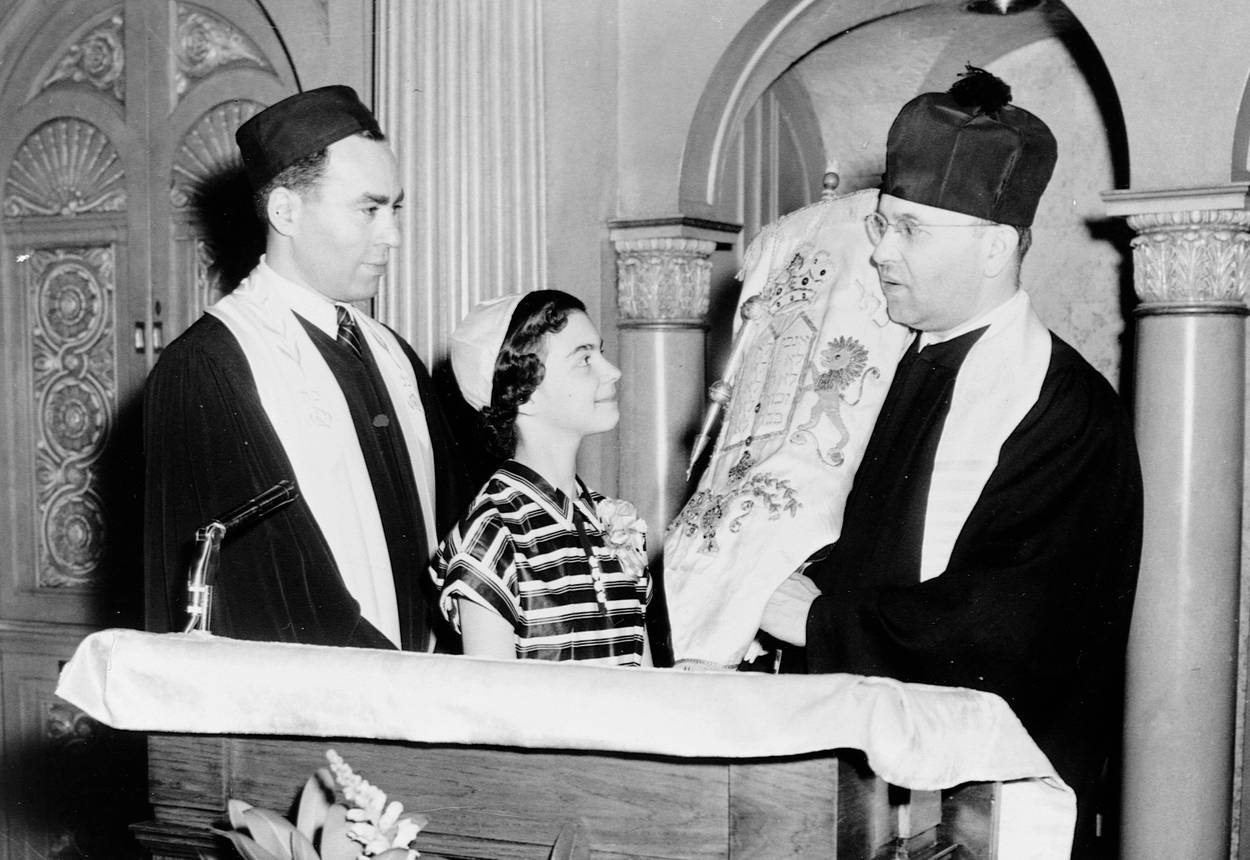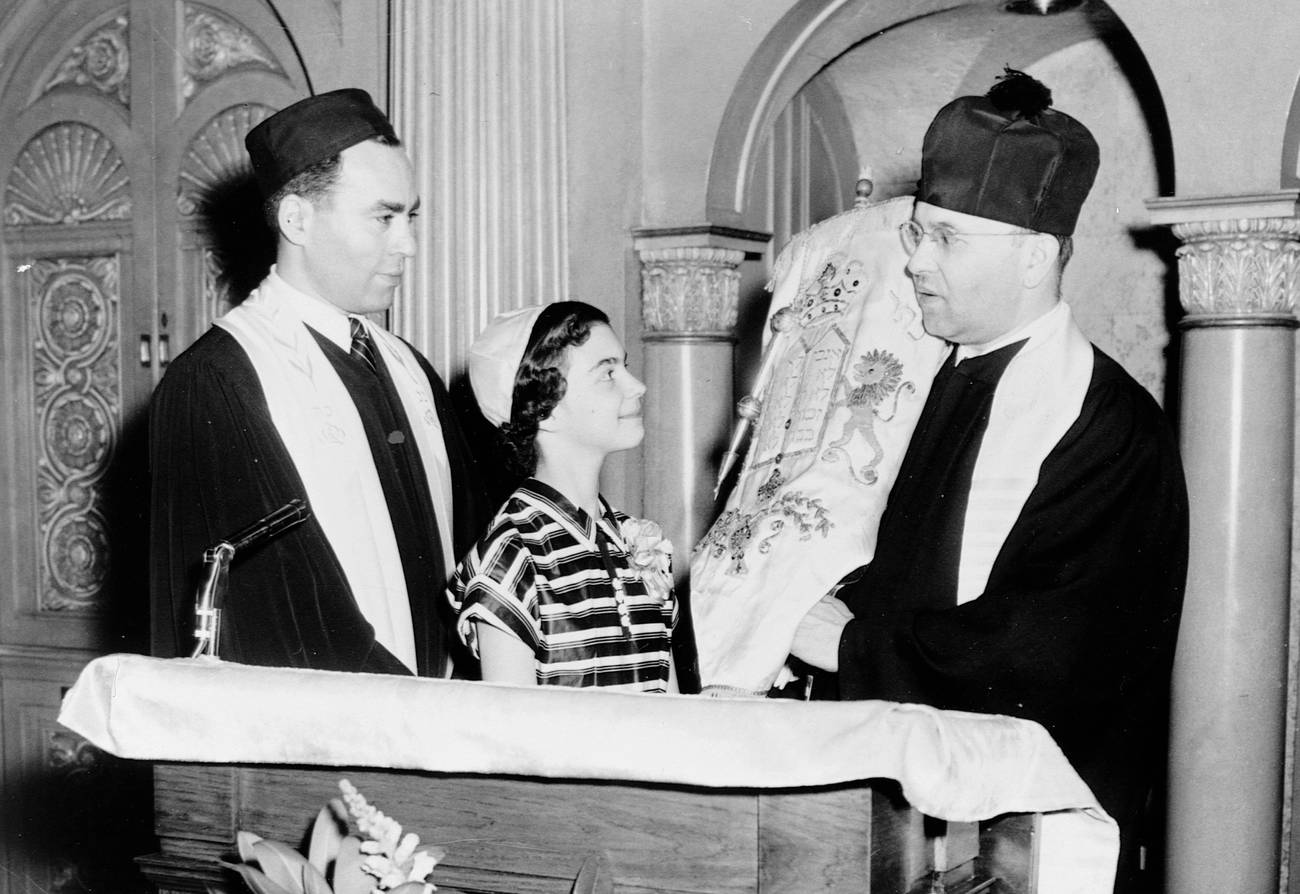The Slow Rise of the Bat Mitzvah
The first ceremony a century ago marked a turning point—in retrospect. But the new ritual didn’t catch on for years.




Reckoning with change—when and how it occurs, why it occurs, and what its aftershocks or consequences might be—is the historian’s lot. Sometimes, with the benefit of both hindsight and extensive documentation, everything becomes clear, at least in retrospect; most of the time, it’s more like reading tea leaves.
The outbreak of war, the eruption of natural disasters, or the onset of debilitating illness can be neatly aligned along a fault line of “before” and “after.” Not so ritual change—the process by which new religious practices come into being and existing ones are overhauled or retired. Its trajectory is uneven and bumpy, marked by fits and starts and a dim awareness that something big is in the offing.
Lately, prompted by last month’s widespread and joyful celebrations of the 100th anniversary of the bat mitzvah—you couldn’t open an American Jewish newspaper or website without coming across references to the very first one in 1922—I’ve been thinking a lot about the ways in which the contemporary American Jewish community at the grassroots relates to the altered landscape of the past.
Much has changed between 1922—when the first American “bas mizvah” was held at the Society for the Advancement of Judaism on Manhattan’s Upper West Side—and today, when that coming-of-age ritual is just about everywhere. But the speeches, fundraising appeals, Instagram posts, and women-power-Shabbat services that marked its centennial deployed history as a stepping stone to the present rather than as a notable moment in its own right.
The festivities also make it seem as if, from 1922 onward, the pace of ritual change was inexorable, unstoppable, and assured. When it came to enlarging the parameters of what was once called “women’s sphere,” it was full steam ahead. The foundational story the community told itself, and circulated, was a triumphal one.
Historical reality gives rise to a different story. Back in the day and for several decades thereafter, the bat mitzvah ceremony was not a regular occurrence, not even at the congregation where it was first launched. More sobering still is that its debut doesn’t appear to have been understood at the time as a turning point, a herald of something brand new. It is we, not the original cast of characters, who have transformed the first bat mitzvah into a moment of consequence, or, in the parlance of last month’s celebration, a “landmark.”
Introduced with no fanfare and with no advance preparation by the bat mitzvah girl herself—12-and-a-half-year-old Judith Kaplan, the eldest daughter of Lena and Mordecai who, according to family lore, was informed only the night before that her bat mitzvah would take place the very next morning—the event made barely a dent in, and hardly registered outside, the immediate precincts of the family and those of the SAJ, then a brand new congregational entity, barely 3 months old. As Judith would later famously remark, “no thunder sounded, and no lightning struck.”
The ceremony itself was a modest, circumscribed affair, whose timing as well as text set it apart from the traditional bar mitzvah. For one thing, it was only after the conclusion of the reading of the Torah and Haftorah that Judith was called up. For another, while she recited the customary blessings that accompany an aliyah to the Torah, the passages, which she read in Hebrew as well as in English, did not come from the Torah portion of the week. Handpicked instead by her father, they were drawn from Leviticus. And for a third, the bat mitzvah girl did the honors from a printed text, not from a Torah scroll, which lay just a few feet away, wrapped up tight and ready for its return to the ark.
The spirit of the occasion was equally restrained, more in keeping with the low-key bar mitzvah of Eastern Europe than with the “big shebang,” the increasingly outsize, extravagantly scaled affair characteristic of modern American Jews. It took the form of a kiddush, a collation at the synagogue following services, and a celebratory dinner at home later that evening.
Given Mordecai Kaplan’s well-known position in the interwar American Jewish community, where his novel ideas about what constituted Jewish expression, practice, and fidelity in the modern era made his a household name, you would think that introducing a newfangled ritual would have occasioned a raised eyebrow, or, at the very least, generated a sentence or two in the press of the time. Nada. No one seems to have batted an eye. Or paid attention.
Then again, Kaplan himself didn’t make much of the bat mitzvah, either. Following a rather lengthy entry in his diary of March 28, 1922, in which he first muses on the relevance of kashrut in modern-day America and then fumes at the lackluster show of interest in a meeting he had called to discuss Jewish education, the communal leader tersely, and almost casually, records that “last Sabbath a week ago (March 18), I inaugurated the ceremony of the bas mizvah”—the last two words written in Hebrew—“at the SAJ Meeting House (41 West 86th Street)—about which more details later. My daughter Judith was the first one to have her bas mizvah celebrated there.”
Not only did Judith’s father “bury the lede,” so to speak, but he documented the event 10 days after its debut, making it seem more ho-hum than memorable. He then skipped a space—and a beat—on the page of his journal to record that on the very same day of Judith’s bat mitzvah, later that afternoon, he lectured on “The Pragmatic Interpretation of the Bible” to a group of teachers at Stephen Wise’s Free Synagogue, intimating that the Shabbat of Judith’s bat mitzvah was business as usual chez Kaplan.
As it happened, he buried more than the lede. The promise of additional details never materialized. There’s nothing in Kaplan’s diaries, fore or aft March 28, 1922, or in his contemporaneous published writings and sermons, to indicate that the bat mitzvah was front and center in his thinking about the revitalization of Jewish life. Though he did speak often and publicly about the importance of Jewish education for women as well as men, there’s also nothing to suggest that under the right circumstances—a shul of his own where he, not the balabatim, called the shots—a bat mitzvah would be one of the first things he’d set in motion to advance the cause.
But that’s precisely what Kaplan did. No sooner had the members of the SAJ settled into their makeshift seats than their newly elected “leader for life” introduced the first in what would become a cascade of ritual changes. Some of his concomitant innovations at the West 86th Street institution, such as the abolition of the Kol Nidre prayer, generated an immediate storm of protest, staying his hand; others, like tinkering with liturgical references to the restoration of sacrifices, were done on the sly, “surreptitiously,” and attracted little notice. Still others, like instituting mixed seating in the sanctuary, were temporarily put on hold; Kaplan was prepared to wait it out until all of the men and women of the congregation were good and ready to sit side by side.
Bat mitzvah, in contrast, called forth no such strategizing and temporizing, no brickbats and no hurrahs, either. That Kaplan and his lay leadership saw eye to eye on and welcomed the innovation with a marked absence of drama is supported by a reference a year later in a handsome booklet with deckled edges that commemorated the first anniversary of the SAJ in 1923. In it, under the rubric of “Our Activities,” which included religious services, Hebrew school, and lectures, the text read as follows: “Bas Mizvah Ceremony: Realizing the important service the Jewish woman is capable of rendering in a revival of Jewish life, we have introduced the ceremony of formally initiating the young Jewess into the Jewish fold.”
The promotional gambit continued: “The young girl thus becomes a Bas Mizvah on the Sabbath following her twelfth birthday through an impressive ceremony similar to that by which the Jewish lad becomes a Bar Mizvah.”
Together with her male counterpart, she was also expected to sign a pledge to continue her Jewish education for several years.
Despite the institutional seal of approval, the bat mitzvah was slow to take off, its practice occasional and intermittent. By 1933, interest in the ritual, never too pronounced to begin with, seemed to have slackened dramatically, prompting its progenitor to relate that it had “fallen into desuetude of late.” Whatever the cause—perhaps there were too few 12-year-old Jewesses on hand at SAJ to render it a going concern, or the pledge was too onerous a responsibility for teenage girls to take on, or maybe the realization that its import was far more symbolic than real militated against its adoption—Kaplan resignedly expressed the hope that the bat mitzvah ceremony might be “kept up regularly.”
It wasn’t. The bat mitzvah may have arrived on the scene like a bolt out of the blue, but it remained a subdued presence well into the postwar era, when it came into its own. The ritual’s gradual evolution over time challenges historians like me to search hungrily for clues, telltale foreshadowings, of both its antecedents and its staying power. Until new primary sources come to light, we remain in the dark. Which, in a way, makes the eventual success of the bat mitzvah even more remarkable. And all the more worth celebrating a century later.
Jenna Weissman Joselit, the Charles E. Smith Professor of Judaic Studies & Professor of History at the George Washington University, is currently at work on a biography of Mordecai M. Kaplan.